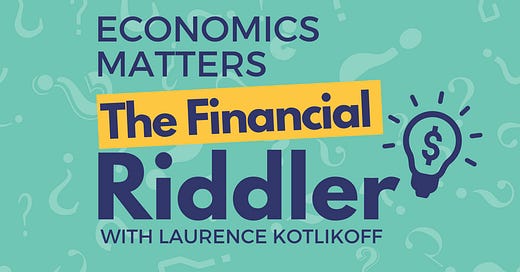The Financial Riddler 6/30/24
Knowledge is infectious. Infect someone. Just send their emails to kotlikoff@gmail.com and they'll receive free lifetime subscriptions to Economics Matters-- the Podcast, Newsletter, and Riddler!
Which country that the larger GDP? Russia or Italy?
a. Russia
b. Italy
And the answer is …
Russia. Italy’s GDP is $2.1 trillion. Russia’s is $2.2 trillion.
What share of Americans never or seldom attend church?
a. 92 percent
b. 82 percent
c. 61 percent
d. 56 percent
e. 37 percent
f. 26 percent
g. 14 percent
And the answer is …
The answer, from Gallup, is 56 percent. At the turn of this century, two in five Americans attended religious services one a week. Today it’s one in five. Back then, one in 10 Americans indicated they had no religious affiliation. Today’s figure is two in 10. Back in 1950, 98 percent of the public said they believe in God. Now the share is 81 percent.
How many religions are there in the world?
a. 25
b. 250
c. 2,500
d. 5,000
e. 10,000
And the answer is …
The answer is 10,000. That may explain why one in five of the world’s inhabitants don’t believe in God. They don’t know which religion, with its own God or version(s) of God, to choose. Hindus, on the other hand, aren’t dissuaded by multiple Gods. They have seven. Yet Hindus are highly religious. Most have their favorite God, but most also believe the seven principal Gods are all manifestations of a single God. Hindus, by the way, are the best educated of any religious group in the U.S. and Europe. Another interesting fact — four in ten believe in reincarnation.
What is the Congressional Budget Office’s projected ratio of federal debt to GDP in 2053?
a. 83 percent
b. 91 percent
c. 127 percent
d. 153 percent
e. 171 percent
f. none of the above
And the answer is …
The answer is none of the above. It’s 181 percent of GDP! Our country is going broke hand over fist. Tell that one to your grandkids.
The debt to GDP ratio in 2015, the year before President Trump’s took office, was 72.2 percent. In 2020 — his last year in office, the ratio was 98.7 percent. Federal spending shot up to fight the pandemic. What was the 2023 debt-to-GDP ratio?
a. 77.7 percent
b. 83.5 percent
c. 91.6 percent
d. 97.3 percent
e. 101.9 percent
f. 106.8 percent
And the answer is …
The answer is 97.3 percent. The 2024 ratio is, obviously, not yet available, but Biden was handed a bad fiscal deal that he’s improved a bit. He had considerable help from inflation, which increased the nominal value of GDP without increasing the nominal value of the debt, most of which was issued in the past, if not far in the past. In other words, inflation watered-down the real value of the debt.
How much did Nividia’s market cap rise between April 24th and May 24th of this year?
a. $76 billion
b. $274 billion
c. $630 billion
d. $1 trillion
And the answer is …
The answer is $1 trillion. That’s beyond amazing. Only 19 countries in the world have GDPs that large.
In 2029, the world’s longest rail and motor vehicle tunnel, now under construction, will connect which two countries?
a. Malasia and Singapore
b. Switzerland and Austria
c. England and Ireland
d. Germany and Denmark
And the answer is …
The answer is Germany and Denmark. The Fehmarnbelt Tunnel will be 18 km long and reduce the travel time between Hamburg and Copenhagen from 4.5 to 2.5 hours. It will cost 12 billion euros. That’s actually trivial compared to the most expensive infrastructure ever — the U.S. interstate highway system that, in today’s dollars, cost over $4 trillion and runs 47,000 miles. It took 35 years to complete.
How much have real house prices (prices adjusted for inflation) risen since 2019?
a. 3.4 percent
b. 7.7 percent
c. 10.3 percent
d. 15.2 percent
e. 23.8 percent
And the answer is …
The answer is 23.8 percent. Yet median real weekly earnings haven’t risen since 2019 apart from a short-lived compositional spike during COVID when low-wage workers disproportionately lost their jobs. What’s up? Very few new homes are coming on the market. The number in May was 481,000, only 7 percent higher than in 2008. Relative to GDP, new home starts are down 26 percent since 2002. High interest rates are depressing construction. And low past mortgage rates are keeping many homeowners from moving. They don’t want to finance a new home at 7 percent. Hence, many existing homes aren’t coming on the market compared to what otherwise would be the case. In short, the increase in real home prices seems to reflect supply shifting down relative to demand rather than demand shifting up relative to supply.





On Q #4, Trump's last complete year in office was 2020 (not 2019).
Making excuses for Biden as usual.